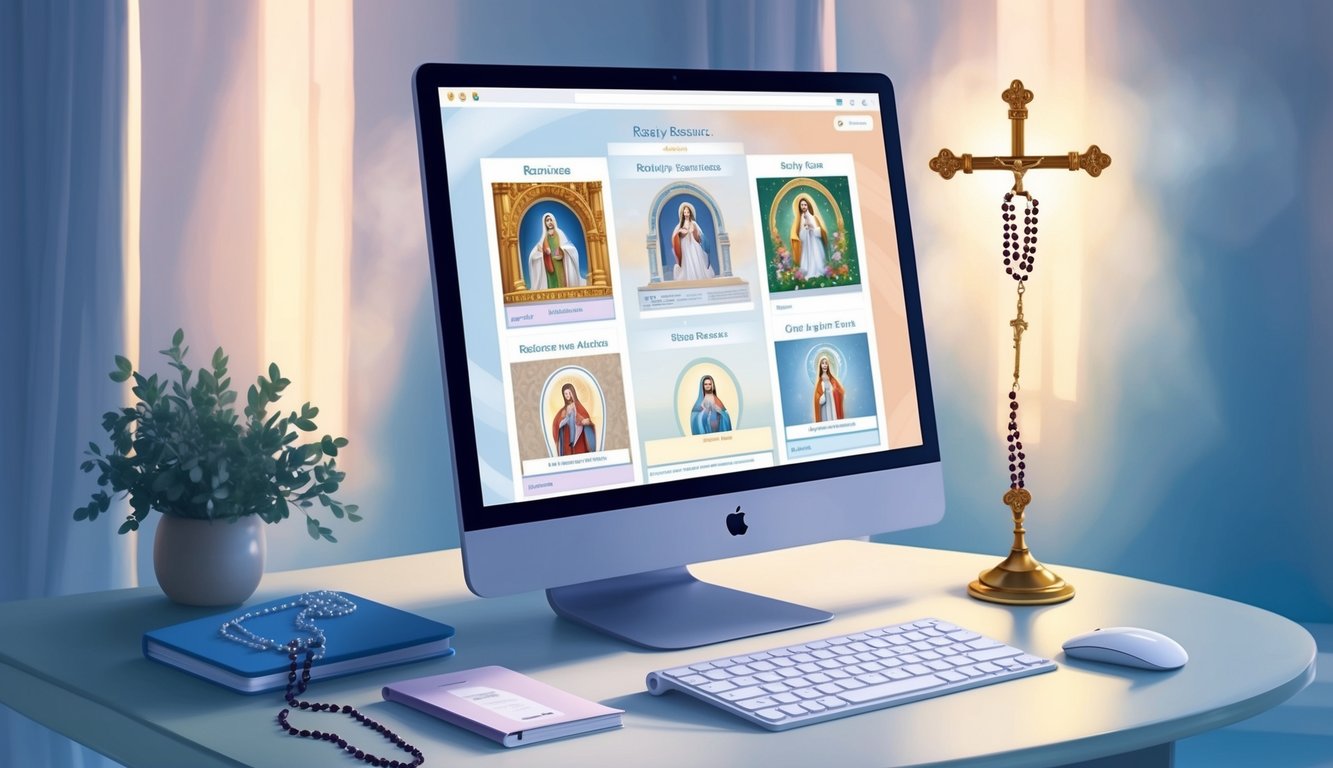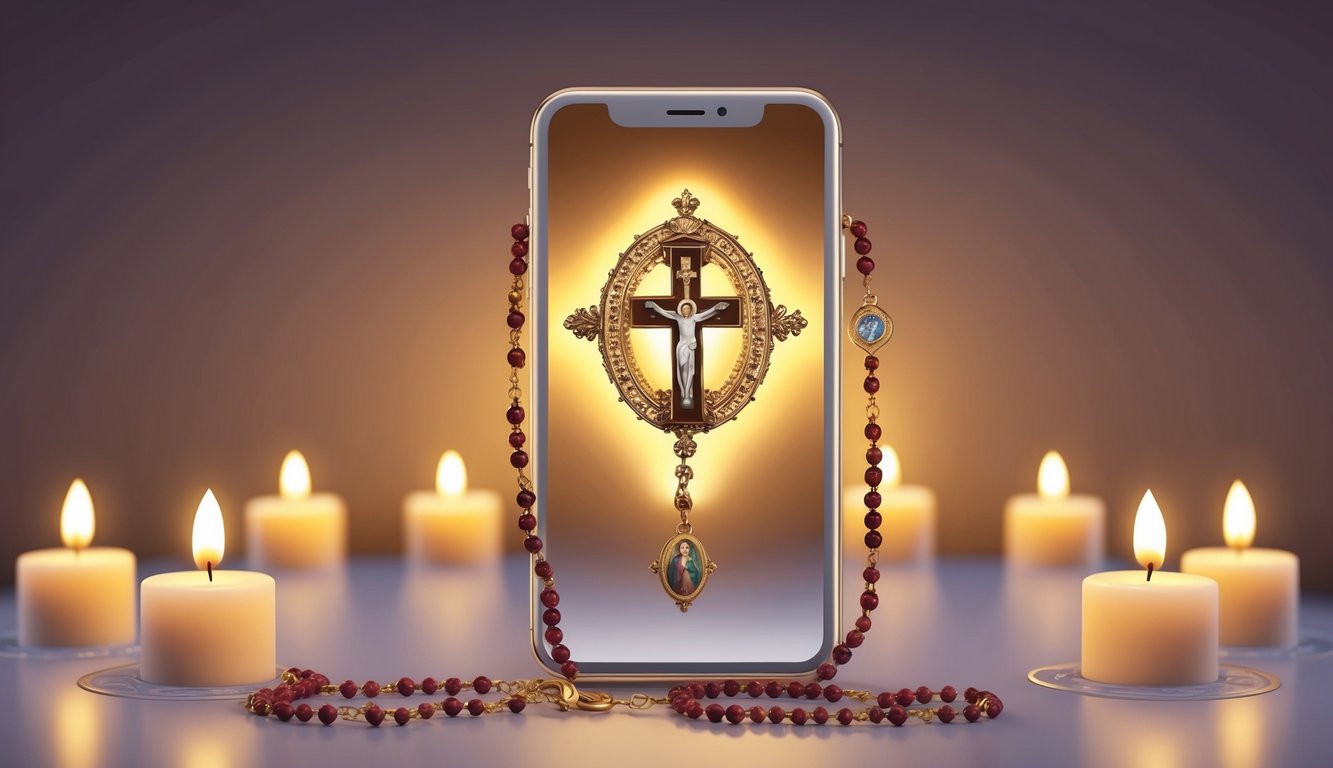Don’t Miss Out On This Unique Astrological Opportunity
Are you tired of spinning your wheels and getting nowhere? Simply put, you’re out of sync: you’re out of alignment with your astral configuration.
But: there’s a kind of map that can help you reclaim your alignment. Think of it as your own personal blueprint to success and happiness: a blueprint that will help you live your most amazing life.
Get started here.
In today’s digital age, you may find it easier to enhance your faith through digital tools.
You can integrate this sacred practice into your daily routine wherever you are, simply using your computer or smartphone.
Exploring the Rosary online allows you to use guided prayers, digital rosary beads, and even virtual prayer groups to deepen your prayer experience.
The Rosary holds a significant place in spiritual life, providing a method to spend time in reflection and prayer.
The digital method provides the same structure as traditional rosary prayer, allowing you to engage with each mystery and meditate on its meaning.
Whether you’re new to this practice or seeking new ways to connect, online resources can offer valuable support and convenience.
For those interested in learning more about the historical and cultural importance of the Rosary, online platforms can assist with a variety of educational materials, from articles to videos.
You can find interactive guides and resources that will help answer common questions about its significance and evolution throughout history.
Key Takeaways
- The online Rosary offers accessible prayer opportunities.
- Interactive guides enhance understanding of the Rosary.
- Digital resources support spiritual growth through prayer.
The Essence and Structure of the Rosary

The Rosary is a significant prayer tool in Catholicism, used for meditation on the life of Christ and the Blessed Virgin Mary.
It is composed of specific prayers and structured with “decades” that guide this devotion.
Significance and Purpose
The Rosary is not just a set of prayers but a path for spiritual reflection.
Its significance lies in its ability to lead you into a meditative state, drawing you closer to the divine through contemplation.
You journey through the life of Jesus Christ and the virtues of Mary, known as the Mysteries.
Each Mystery gives you a chance to reflect deeply on your faith.
This devotion is meant to guide you toward peace and understanding.
When you say the Rosary, it combines both verbal and silent reflections, keeping your mind focused on sacred events.
The repetitive nature can help reach a meditative calm, deepening your spirituality.
Components and Prayers
The Rosary consists of several prayers and structured elements.
You begin with the Sign of the Cross, followed by the Apostles’ Creed to profess faith.
Each decade includes one Our Father, ten Hail Marys, and one Glory Be.
After each decade, you may say the Fatima Prayer for deeper contemplation.
The complete Rosary has five decades, and you ponder a different set of Mysteries: Joyful, Sorrowful, Glorious, or Luminous.
The closing includes the Hail Holy Queen, summarizing the devotion.
This structure ensures that each prayer and mystery plays a part in drawing you closer to understanding and peace.
Each element works together to create a comprehensive prayer cycle.
Through this, you find a consistent reminder of faith’s power in daily life.
Spiritual Practices Surrounding the Rosary
In practicing the Rosary, you engage in deep meditations and follow a specific schedule aligned with different days of the week.
Each day highlights particular mysteries and themes that guide your spiritual journey.
Meditations and Intentions
When you pray the Rosary, meditation plays a crucial role.
You focus on different intentions and virtues such as love, hope, and salvation.
Each bead represents a Hail Mary prayer, during which you reflect on the mysteries of faith.
Different sets of mysteries help in guiding your thoughts.
The Joyful Mysteries, for instance, emphasize joy and hope.
The Sorrowful Mysteries focus on suffering and salvation.
Glorious Mysteries remind you of the triumph of faith, while the Luminous Mysteries highlight the teachings of Christ.
Through meditation, you connect deeply with your spiritual core, enhancing your understanding of each mystery.
These sessions align your everyday life with virtuous living.
Days of the Week and Corresponding Mysteries
The Rosary follows a specific daily cycle, aligning with different mysteries for each day.
For example, on Mondays and Saturdays, you revisit the Joyful Mysteries.
These focus on themes like the birth of Christ.
Tuesdays and Fridays immerse you in the Sorrowful Mysteries, reflecting on the passion and sacrifice of Jesus.
On Wednesdays and Sundays, you’re encouraged to meditate on the Glorious Mysteries, exploring resurrection and eternal life.
Thursdays center around the Luminous Mysteries, which focus on illuminated moments like the Last Supper.
This structured approach helps in keeping your practice organized and meaningful, letting you fully engage with each aspect of your faith journey.
The Rosary in Historical and Cultural Context

The rosary has deep roots in history, intertwining with many significant events and figures.
You will discover how its origins have evolved over time and its cultural importance.
Origins and Evolution Over Time
The rosary traces its roots back to the early Christian practices, with its association with prayer and reflection being evident.
Initially, simple prayer beads were used to track prayers.
In the 13th century, Saint Dominic is often credited with promoting the structured format known today.
The rosary symbolizes the Crown of Roses offered to Mary, a spiritual bond forming between people and the Blessed Virgin Mary.
Over time, it has become a central element in Catholic devotion.
During the late Middle Ages, the Catholic Church encouraged the use of the rosary.
The practice spread significantly in devotion to events like the Annunciation and the Nativity.
By the 16th century, the rosary became formalized, reflecting key Catholic beliefs.
This prayer practice strengthens the faith and spiritual connection for many believers.
Associations with Events and Figures
Throughout history, the rosary has been linked with significant religious and cultural events.
The apparition of Mary at Fatima increased its popularity, reinforcing its importance in Catholic tradition.
Believers around the world turn to the rosary in times of crisis, finding comfort in its meditative prayers.
The Hail Mary prayer Catholic faithful recite serves as a cornerstone of devotion, strengthening their connection to Mary and her intercessory power.
From private reflections to large public gatherings, the rosary remains a symbol of faith and perseverance.
Some even associate it with moments like the Presentation and the Holy Family.
Prominent figures such as saints and popes have promoted the rosary.
Pope Leo XIII dedicated October to the Holy Queen and the rosary.
This month-long devotion highlights the rosary’s spiritual power.
Mary’s guidance is especially celebrated as her protective influence over believers is invoked.
The rosary also plays a part during Christmas, with prayers focusing on the Nativity and other mysteries of Jesus’s life.
You will find that the rosary offers a way to commune with the Lord, reflecting on His life and the Holy Family.
This tradition is deeply embedded in the Catholic Church and the Communion of Saints.
Finding and Utilizing Rosary Resources Online

Accessing rosary resources online can greatly enhance your spiritual practice.
With digital tools, you can choose platforms that offer interactive experiences, guided sessions, and detailed instructions on the Sacred Mysteries.
Choosing the Right Digital Platform
Selecting the right online platform is key to practicing the rosary with ease and depth.
Look for websites or apps that provide videos with instructions, allowing you to follow along at your own pace.
Some platforms focus on the Sacred Heart of Jesus and the Immaculate Heart of Mary, while others may help you contemplate the Holy Spirit.
Platforms like Marian Library can offer digital exhibits or recording rosaries to aid your practice.
Evaluate features such as ease of use and whether they offer meditative areas to focus on eternal life and sacred contemplation.
Interactive Tools and Guided Sessions
Interactive tools can enrich your rosary experience by providing guided sessions and prompts.
Platforms that offer detailed instructions on the Rosary’s Sacred Mysteries can help draw you closer to its spiritual meaning.
Some apps include interactive guides that assist you in meditations on the Immaculate Heart of Mary or teachings of the Sacred Heart of Jesus.
Consider tools that allow you to join Catholic communities online, providing a shared space to explore and discuss.
Guided sessions often include real-time feedback, prayer reminders, and options to listen to audio prayers.
Options like Springer’s study highlight the positive effects these tools can have on health and well-being.
Frequently Asked Questions
Exploring online resources for praying the Rosary offers flexibility in practice.
You’ll discover various websites, digital tools, and video platforms that provide guidance and community support.
How can I pray the Rosary online?
You can use apps or websites designed for the Rosary, such as iRosary, which offer digital guides and audio sessions.
These platforms often include instructional materials to help you follow along, including the prayers and mysteries.
Where can I find a daily online Rosary for today?
Websites like Catholic Online provide daily Rosary prayers.
You can also find community groups on social media platforms offering live streaming sessions.
These groups typically update their schedules regularly to accommodate daily practices.
Is there a recommended YouTube channel for praying the Rosary?
There are several YouTube channels dedicated to Rosary prayer.
Searching for “Rosary prayer” on YouTube will yield many options, featuring both live sessions and prerecorded videos to follow at your convenience.
Can I use virtual Rosary beads to pray online?
Yes, virtual Rosary beads are available through several apps and websites, offering interactive or visual representations.
They guide you through each bead and prayer sequence, providing a similar experience to using physical beads.
What is the correct way to pray the Rosary?
Praying the Rosary involves a specific sequence of prayers: the Apostles’ Creed, Our Father, Hail Marys, Glory Be, and the mysteries.
Online resources and guides can offer step-by-step instructions to ensure you’re following the traditional method accurately.
Does the day of the week change how the Rosary is prayed online?
Yes, the mysteries meditated upon during the Rosary can change based on the day of the week.
Many online platforms will guide you through the appropriate mysteries to reflect upon.
This ensures that you follow the traditional schedule.



